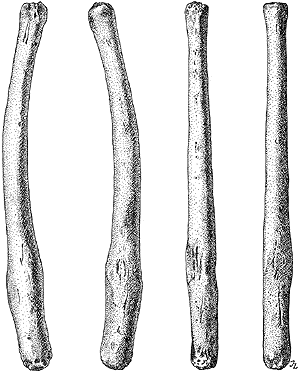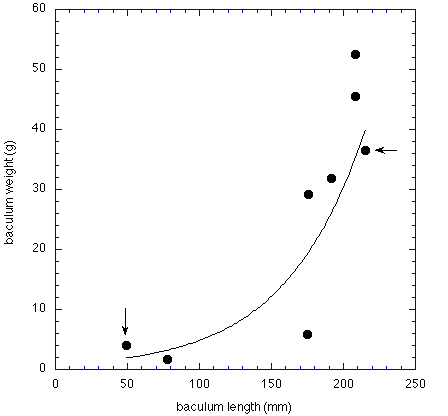 |
|
|
 |
||
ON A FEW BACULA OF MEDITERRANEAN MONK SEALS
Peter J.H. van Bree
Zoological Museum, University of Amsterdam
P.O. Box 94766, 1090 GT Amsterdam, the Netherlands
 |
|
|
 |
||
ON A FEW BACULA OF MEDITERRANEAN MONK SEALS
Peter J.H. van Bree
Zoological Museum, University of Amsterdam
P.O. Box 94766, 1090 GT Amsterdam, the Netherlands
Havinga (1933) was probably the first zoologist who used the length/weight relation of seal penis bones (bacula) for relative age determination. This was contained in his classic study on Harbour Seals. As is now generally known, these bones mainly grow in length till puberty, afterwards they mainly become heavier. At present, bacula are often used in growth and age studies, see e.g. Miller et al. 1998.
The penis bones of Monk Seals, however, have yet to be used for such purposes because very little is known about these bones. Chaine (1925) was the first to describe and to illustrate the baculum of a subadult Monk Seal. The present author, in 1994, published a note on the penis bone of a full grown specimen (Fig. 1). Up to now, that is all that is known from literature.

Fig. 1. Baculum of a full grown monk seal, Monachus monachus, from the Aegean sea. Length 215 mm. Illus. J. Zaagman.
During the mass die-off of Monk Seals of the Mauritania/Western Sahara colony in 1997, many animals found dead were dissected. The results of these dissections (even the most basic data such as the number of males and females, their lengths, their relative ages, etc.) are unfortunately not yet published. Thanks to the kind cooperation of the Mauritanian authorities the bacula of six specimens were donated recently to the Zoological Museum of the University of Amsterdam (ZMA). The bones were cleaned, dried, registered, measured and weighed. The data are:
ZMA 25.336, dissected on 6-VI-1997, total length of the animal (tip of the nose till end of longest toe ) 197 cm, length baculum 78.0 mm, weight 1.6 g.
ZMA 25.390, dissected 28-V-1997, TL 228 cm, l. bac. 175 mm, w. bac. 5.9 g.
ZMA 25.391, dissected 23-V-1997, TL 260 cm, 1.bac. 191.5 mm, w. bac. 31.9 g.
ZMA 25.392, dissected 4-VI-1997, TL 264 cm, 1.bac. 176.0 mm, w.bac. 29.2 g.
ZMA 25.393, dissected 21-V-1997, TL 246 cm, 1.bac. 208.1 mm, w.bac. 45.5 g.
ZMA 25.394, dissected 28-V-1997, TL 265 cm, 1. bac. 208.4 mm, w.bac. 52.5 g.
These data are too few to be used in isolation, but they may be useful in future when more bacula become available. At present it can only be said that specimens ZMA 25.393 and ZMA 25.394 are certainly of old males. This conclusion is suggested by a comparison of these specimens with the baculum mentioned by the author (loc. cit.), which was from a 254 cm long Monk Seal from near the Island of Skopelos, Northern Sporades, Greece. The length of that penis bone was 215 mm and its weight 36.5 g. A canine of that animal was sectioned and its age was determined, which was 23 years.
The second Monk Seal with a total length of 157 cm, of which the baculum is preserved and of which its age is known, is an animal that was born in a cave on a small island off the town of Foça in Turkey on 16-X-1996. It drowned entangled in a fishing net 117 days later. The baculum of that young seal has a length of 49 mm and a weight of 4.0 g. The length/weight data of the bacula of these two Monk Seals, of which we know the age, are also given in figure 2.

Fig. 2. The length/weight relation of the bacula of 8 Mediterranean Monk Seals. The specimens with known age are indicated by an arrow (see text).
Acknowledgements
The author gratefully acknowledges the help of Mrs. E.J. Vedder, who took the bacula to the Netherlands, of Mrs. Chr. Lockyer, who determined the age of the Monk Seal from Greece, and of the members of the Foça branch of the Underwater Research Society in Turkey for furnishing the data of the young seal.
Literature
Bree, P.J.H. van (1994). On the baculum of the Mediterranean Monk Seal, Monachus monachus (Hermann, 1779). Mammalia, 58 (3): 498-499.
Chaine, J. (1925). L’Os pénien, étude descriptive et comparative. Act. Soc. Linnéenne Bordeaux, 78: 5-195.
Havinga, B. (1933). Der Seehund in den Holländische Gewässer. Tijdschr. Ned. Dierk. Ver., (3) 3: 79-111.
Miller, E.H., A.B.J. Stewart & G.B. Stenson (1998). Bacular and testicular growth, allometry, and variation in the Harp Seal (Pagophilus groenlandicus). J. Mammalogy, 79 (2): 502-513.
Copyright © 1999 Peter J.H. van Bree, The Monachus Guardian. All Rights Reserved